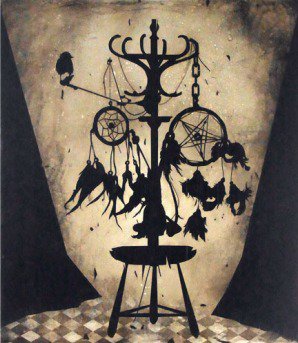Henning Kles
dal 3/3/2011 al 8/4/2011
Segnalato da
3/3/2011
Henning Kles
Wendt+Friedmann Galerie, Berlin
Real and cinematic dystopias are the subject matter of these new paintings. Henning Kles draws on classic expressionist films such as 'Nosferatu' or doomsday films such as the 'Soylent Green' (1973) as sources. Alongside sources of inspiration from cinema, Henning Kles also frequently draws upon a large stock of media images from magazines, newspaper and advertising material.

An upright skeleton pokes around in the ground with a pole. A figure
dressed in black kicks a crawling person, while four others look on. A
group of eight masked characters are shown from behind as they stand
in front of a large source of light – the lettering on their hooded
jackets indicates that they are a gang. Grotesque figures that look
like they are from a chamber of horrors. The characteristic curved bay
windows of the luxury Atlantic Hotel in Hamburg mutate into the stern
of the Titanic with a tattered flag against a dark night sky.
The new set of works that the Hamburg artist Henning Kles (born 1970)
has been working on since the start of 2009 refers back to his earlier
paintings in terms of the choice of motifs. Real and cinematic
dystopias are the subject matter of these new paintings. Henning Kles
draws on classic expressionist films such as "Nosferatu" or doomsday
films such as the "Soylent Green" (1973) as sources. More recently, he
has also been informed by the elaborate silhouette animation films of
Lotte Reininger (1899-1981), which were particularly influential in
terms of style in the 1920s.
Initially, his new paintings look more like graphic prints. However,
every painting is actually a laboriously produced unique piece. In his
generally medium-scale to small-scale paintings, Henning Kles uses a
black bitumen emulsion, a material not typically used in art and which
is actually employed in the construction industry. Medium-thickness
painters' cardboard serves as a medium, which is then covered with
this viscous liquid material. The painting surface is covered using
masking tape, and a sketch is drawn here. A cutting knife is then used
to remove parts of the surface in a number of steps. In this process,
Kles has to make artistic decisions similar to those that arise when
working on etchings, woodcuts or lithography. Finally, the paint is
carefully removed using wood turpentine. In this way, a subtractive
process results in the finished painting with varying dark brown,
ochre and black tones. With their reduction to contrasts between
bright and dark, Kles‘ new works initially look as if they have been
cut out using a scissors. At the same time, however, they are
surrounded by a smoky, toxic sfumato: remnants of paint, drops of
turpentine and other hazes all combine to create diffuse effects.
Alongside sources of inspiration from cinema, Henning Kles also
frequently draws upon a large stock of media images from magazines,
newspaper and advertising material. These could be photos of riots or
catastrophes, or, for example, an image of dead cattle, in whose
bizarrely tied-up legs the painter manages to discover abstract
elements.
Old art catalogues with Chinese sculptures or photographic
reproductions of Roman portraits also add to the artist's ever-growing
stock of images. However, this apparently random collection still has
to pass through a selective filter system before it is used in Kles‘
paintings. On this matter, Henning Kles himself says: "All of the
source material that I use – regardless of whether from film stills
or newspaper cuttings – is steeped with meaning, so I first have to
process it and extract it from its context so that it can then be
rearranged in a new way on canvas, presented on a new, unused stage
and viewed in a liberated manner. Only then are new associations
possible." (1)
Henning Kles has compressed his new paintings into very varied, frieze-
like or tableau-like ensembles for exhibition purposes. In the
viewer's imagination, this method of presentation results in a variety
of narrative strands, which are however in no way explicitly
prescribed by Kles. As with a loosely arranged strip cartoon or comic-
like narration, the paintings draw the viewer into an associative
maelstrom of the ironic-grotesque and of the suggestive and uncanny.
Taking a direct cue from Sigmund Freud's 1919 essay "Das Unheimliche
(The Uncanny)", Kles draws on literary masters of subliminal, menacing
atmospheres such as E.T.A. Hoffmann, Edgar Allan Poe or Franz Kafka.
There is also no mistaking the closeness in terms of motifs to various
underground music genres. A vigorous aesthetic debate on the
fantastic, grotesque, ugly and evil has taken place in recent years.
This debate reveals a widespread and, ultimately, anti-modernist
fascination with certain aspects of all things scary as a playful
counterpoint to the increasingly sleek and stylish corporate world of
major corporations, banks, television channels and publishing houses.
What is beautiful? What is ugly? "Ask the devil", was Voltaire's
response, "He will tell you that beauty is a pair of horns, four claws
and a tail." (2)
Henning Kles‘ paintings in this new group of works, which has yet to
be titled, operate on the interface between laconic everyday and media
observation and the artistic realisation of dark individual and
collective fantasies and premonitions, underfed in terms of motifs by
a forsaken world of the uncanny. With their systematic, expressive
implementation as regards paint and technique, these paintings have
the character of a series which is coherent in terms of form and
content and is also nowhere near being finished.
Nicole Büsing and Heiko Klaas 2010
(1) Henning Kles from a conversation with Michael Diers, in: Henning
Kles: Sliver Surfer, Publisher: Bielefelder Kunstverein, Verlag für
moderne Kunst Nürnberg, 2006, p. 52
(2) From: Umberto Eco: Die Geschichte der Hässlichkeit (German
translation of "On Ugliness"), Carl Hanser Verlag München, 2007, p. 12
Opening Friday March 4, 2011, 6-9 pm
WENDT+FRIEDMANN
Heidestrasse 54, 10557 Berlin
Hours: Wed-Fri 12-6 pm
Free admission



